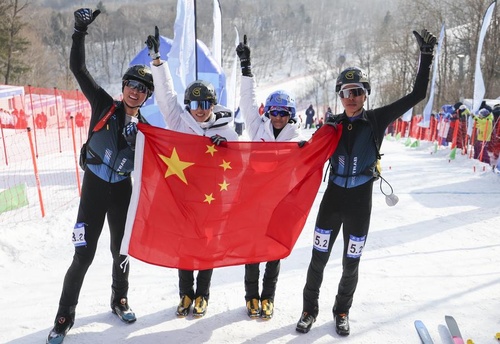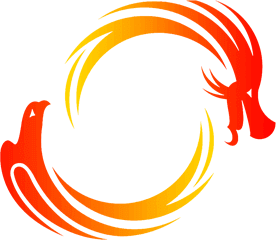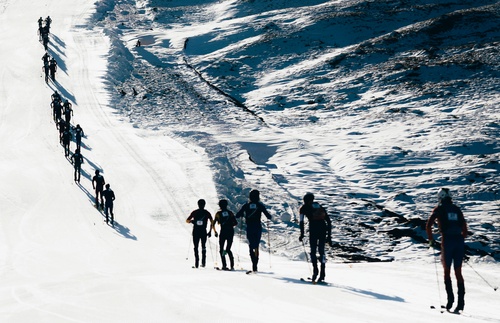


Sports
Skiing
Skiing
Water Skiing is a sport where an individual or moore is pulled behind a motor boat or a cable ski installation.
The surface area of the ski keeps the person skimming on the surface of the water allowing the skier to stand upright while holding the tow rope.
List of disciplines
- Alpine Skiing
- Cross Country Skiing
- Freestyle Skiing
- Nordic Combined
- Ski Jumping
- Ski Mountaineering
- Ski Orienteering
- Skiing
- Snowboard
Alpine skiing otherwise known as downhill skiing is where the athlete has a pair of long flat runners of plastic, metal, or wood that curve upward in front and attached to a boot or foot for gliding or travelling over snow.
In competition speed and accuracy are important. Alpine skiing evolved from cross-country skiing after the invention of the ski lift and was first incorporated into the Asian Winter Games in 1986.
List of events
-
men
-
SLALOM
-
GIANT SLALOM
-
DOWNHILL
-
SUPER-G
-
SUPER COMBINED
-
-
women
-
DOWNHILL
-
SUPER-G
-
SUPER COMBINED
-
GIANT SLALOM
-
SLALOM
-
Cross-country skiing is a popular winter sport where the athletes race to ski along large areas.
Cross-country skiing is part of the growing skiing sport family, which also includes events such as ski jumping, there are many techniques which can be used but Free-technique cross-country skiing is also the method of locomotion in the combination sport of Biathlon, which adds rifle marksmanship to skiing.
Cross country skiing was incorporated into the Asian Winter Games in 2003.
List of events
-
men
-
4X10KM RELAY CLASSIC/FREE
-
50KM MASS START
-
10KM PURSUIT
-
COMBINED 10KM + 15KM PURSUIT
-
15KM SKIATHLON
-
INDIVIDUAL SPRINT
-
1.4KM INDIVIDUAL SPRINT CLASSICAL
-
30KM FREE MASS START
-
4X7.5KM RELAY
-
1.6KM SPRINT CLASSIC
-
1.6KM TEAM SPRINT FREE
-
10KM CLASSIC
-
15KM FREE
-
30KM CLASSIC
-
-
women
-
1.4KM TEAM SPRINT FREE
-
1.4KM SPRINT CLASSIC
-
5KM CLASSIC
-
10KM FREE
-
15KM CLASSIC
-
4X5KM RELAY CLASSIC/FREE
-
30KM MASS START
-
7.5KM SKIATHLON
-
INDIVIDUAL SPRINT
-
1.4KM INDIVIDUAL SPRINT CLASSICAL
-
15KM FREE MASS START
-
4X5KM RELAY
-
It has been suggested that, Freestyle skiing is a product of America in the 1960s, when social change and freedom of expression led to new and exciting skiing techniques.
Originally a mix of alpine skiing and acrobatics, freestyle skiing developed over the decades into the present-day Olympic sport.
The International Ski Federation (FIS) recognised freestyle as a discipline in 1979 and brought in new regulations regarding certification of athletes and jump techniques in an effort to curb some of the dangerous elements of the competitions.
The first FIS World Cup series was staged in 1980 and the first FIS World Championships took place in 1986 in Tignes, France, featuring moguls, aerials and ballet.
Freestyle skiing, where skiers perform aerial manoeuvres while skiing downhill, was a demonstration event at the Winter Olympic Games in Calgary in 1988.
Mogul skiing was added to the official programme of the Albertville Games in 1992 and Aerials were added at the Lillehammer Games in 1994.
List of events
-
men
-
SKI HALFPIPE
-
SKI SLOPESTYLE
-
MOGULS
-
DUAL MOGULS
-
AERIALS
-
SKI CROSS
-
-
women
-
MOGULS
-
DUAL MOGULS
-
AERIALS
-
SKI CROSS
-
SKI HALFPIPE
-
SKI SLOPESTYLE
-
Nordic combined has its 5,000 year-old roots in Norway. It involves ski jumping, which requires physical strength and technical control, and cross-country skiing which demands endurance and strength.
Nordic combined individual events have been included since the 1st Olympic Winter Games in Chamonix - Mont Blanc in 1924.
List of events
-
men
-
TEAM LH + 4X5KM RELAY
-
INDIVIDUAL LH + 10KM
-
Ski jumping has been part of the Olympic Winter Games since the first Games in Chamonix Mont-Blanc in 1924.
The Large Hill competition was included on the Olympic programme for the 1964 Olympic Games in Innsbruck.
List of events
-
men
-
K-95 INDIVIDUAL
-
K-125 INDIVIDUAL
-
K-125 TEAM
-
INDIVIDUAL NORMAL HILL
-
TEAM LARGE HILL
-
INDIVIDUAL LARGE HILL
-
-
women
-
K-125 INDIVIDUAL
-
K-95 INDIVIDUAL
-
INDIVIDUAL NORMAL HILL
-
List of events
-
men
-
Sprint Final
-
-
women
-
Sprint Final
-
-
mixed
-
Relay Final
-
Mixed Relay
-
Ski orienteering is a cross-country endurance winter sport. Similar to the orienteering disciplines practised in the summer season, ski orienteering requires an extremely high level of both physical and mental fitness.
An elite level ski-orienteer needs excellent skiing and map reading skills - and the ability to combine those two. The athlete has to take hundreds of route choice decisions at high speed during every race.
The prepared ski tracks are of various quality. Throughout the competition the ski orienteer has to make decisions about which route is the fastest between the controls. The route choice is made on the basis of the quality of the ski tracks, gradient and distance, all of which can be read from the map.
In respect of physical condition, ski orienteering is comparable with marathon running or cross-country skiing. To be successful in ski orienteering, the athlete must master all skiing techniques, classical and free technique as well as all general downhill and turning techniques.
List of events
-
men
-
RELAY
-
SPRINT
-
LONG DISTANCE
-
MIDDLE DISTANCE
-
-
women
-
MIDDLE DISTANCE
-
RELAY
-
SPRINT
-
LONG DISTANCE
-
It was not long before Man worked out how to move quickly through deep snow in the wilder parts of the world, as paintings discovered in the 1930s clearly portray. On the ancient artefacts, which were found in Russia and are thought to be at least 6000 years old, a hunter on rudimentary skis is clearly identifiable alongside reindeers. It is virtually certain that a form of skiing has been an integral part of life in colder countries since that time. Obviously the principal use of skis until recently was for the transportation of goods and people or for the swift movement of soldiers patrolling remote, icy borders. Horses were clearly not much use in three metres of snow, so other methods had to be developed and skis quickly became as natural an accoutrement of everyday life as hats and gloves. The Olympic Winter Games present five disciplines of Skiing: Alpine, Cross Country, Ski Jumping, Nordic Combined, Freestyle as well as Snowboarding. To compete in these various disciplines one needs to master speed, endurance, dexterity, and determination.
Snowboarding was developed in the United States in the 1960s as people across the country began to seek out new winter activities.
Over the next decade, different pioneers boosted the production of boards and the overall interest in snowboarding. Surfers and skateboarders became involved, and by 1980, snowboarding was a nationwide activity.
Competition was the next logical step. Competition and national and international federation influence began in the 1980s.
The United States held its first national championships in 1982 and hosted the first World Championships in 1983.
In 1987, a four-stop World Cup tour was established, with two stops in the United States and two in Europe. The International Snowboarding Federation (ISF) was formed in 1990 and on request of the International Ski Federation (FIS) National Ski Associations, many of which organised ski and snowboard competitions, the FIS introduced Snowboarding as a FIS discipline in 1994.
List of events
-
men
-
HALFPIPE
-
PARALLEL GIANT SLALOM
-
SNOWBOARD CROSS
-
GIANT SLALOM
-
SLALOM
-
-
women
-
HALFPIPE
-
PARALLEL GIANT SLALOM
-
SNOWBOARD CROSS
-
GIANT SLALOM
-
SLALOM
-
Related links
Sports Committee
The Sports Committee consist of one Chairman and a minimum of five members. The Chairman, nominated by his NOC, will be elected by the GA, while the Members preferably representing the 5 zones of t...
Sports and Environment Committee
The Sports and Environment Committee consist of One Chairman and Five Members. The Chairman, nominated by his NOC, will be elected by the GA, while the Members preferably representing the 5 zones o...
Sports for All Committee
The Sports for All Committee shall consist of One Chairman and Five Members. The Chairman, nominated by his NOC, will be elected by the GA, while the Members preferably representing the 5 zones of ...
Sports Federations
-

Asian Federation
Asian Ski Federation
-

International Federation
International Ski Federation





